SAM ROSS TECHNIQUE | STANCE
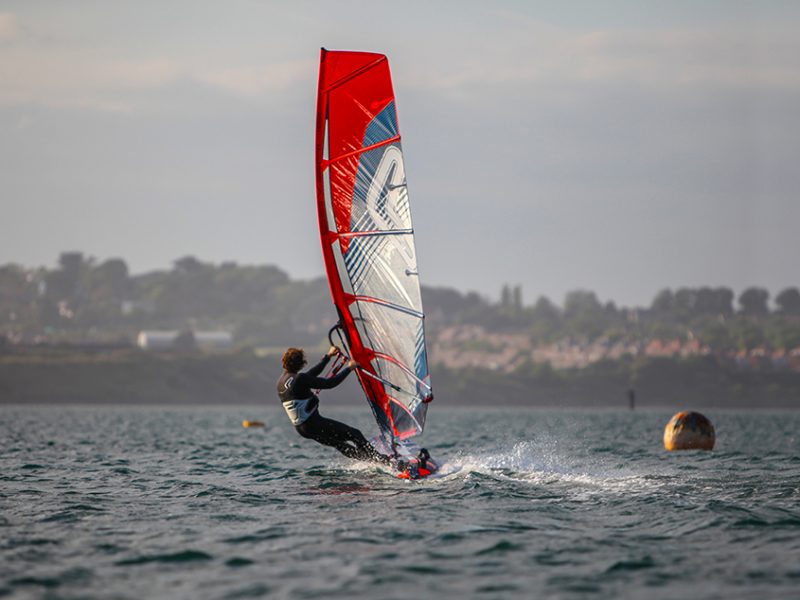
Getting your stance right is a bit like eating your vegetables. We know it’s important and done right could have a dramatic impact, but it’s maybe not as exciting as other things we could be getting stuck into! However, stance is the one bit of windsurfing that joins every single move together, so if you get it right it will allow a huge amount of progression. It’s also the most important thing for sorting your entry to moves, which is where most issues occur.
Words Sam Ross // Photos Dan Hallam
The challenge to overcome with stance is often the perception of what we think good stance looks like, versus what it should look like. From our early windsurfing days we’re told to often do things like ‘commit’, ‘lean back’, ‘get our hips in’, and a few more caustic phrases. Whilst many of these help us overcome short term symptoms, they do create a few long term gremlins that then hold us back at a higher level.
UPRIGHT
The rig reflects our upper body position, so if the focus is on having an upright rig, then we also need to have an upright body. Rig position and harness line tension should be consistent across all wind strengths, our stance range is only really changed by what we’re doing with our legs. In lighter winds our legs are straighter, and in higher winds more flex is needed in the legs and sinking of the hips, but the gap between the harness hook and the rig still has to stay the same. Essentially the head and hips are pretty much vertically in line. The back is upright and therefore so is the rig.
This upright body position gives us loads of advantages whilst we’re windsurfing. With an upright body we’re more on top of the board, allowing us to move without moving the rig and therefore not upsetting the trim. Try leaning against a wall with just your shoulders touching it, now pick one of your feet up and try stepping away from the wall. You probably ended up leaning further back, or even had to push off the wall to make it happen. Now try the same with your back flat against the wall. You should be able to pick your feet up and step away more easily. Think about what this looks like on the water. If I’m in a lent back stance and try to step across the board for the gybe I’m going to have to pull on the rig. So I’ll either stall the board or end up with the rig pinned to me as I go into the gybe. If I’m upright, I can roll my weight across the board, still staying low through the legs and also keep the rig away and forward. In an upright stance I can move or transfer weight without upsetting the rig. So this would be key even in moves like getting into the footstraps, or going for my first jumps where I want to stay over the board to maintain in-flight control. Which is exactly what I would need if I wanted to go into a forward.
“Rig position and harness line tension should be consistent across all wind strengths.”
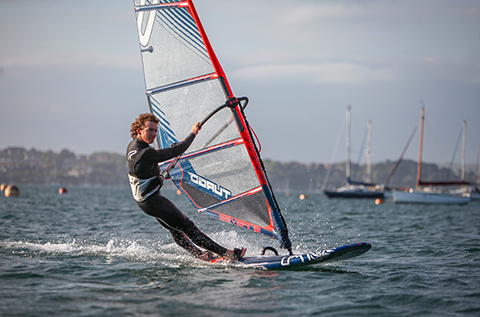
The head, shoulder and hips are in line; the harness squeezing out for maximum tension in the line. Upper body is upright, therefore rig is upright and planted on the board.
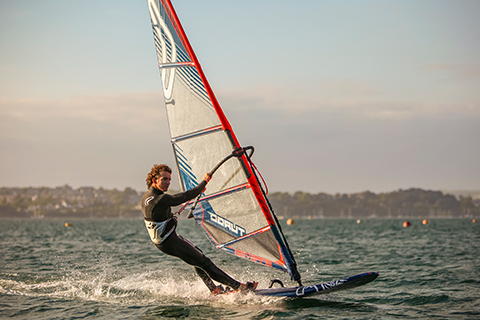
Thumbs on top of the boom to make sure the rig can move away and stay upright, keeping constant load in the harness.
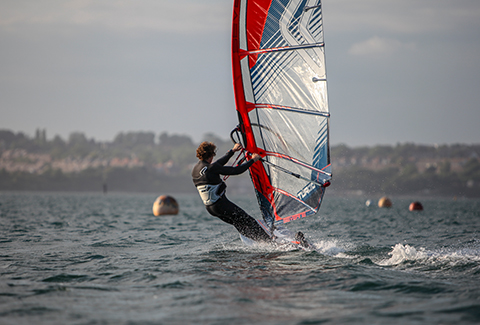
The wind is a little lighter, so legs are straighter and weight is forward. However the hips stay out and the body is upright
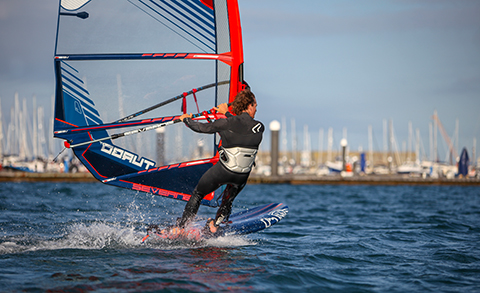
More powered up, the head shoulders and hips are still in line and upright. There is more flex in the back leg, and pressure through the heels to deal with the power. But the upper body position doesn’t change.
HOW DOES IT FEEL
Whilst we can see things like hand placement, stance is harder to quantify and so often overlooked. We should feel as if we’re pushing our hips out and down, or even drawing our belly button back towards our spine. Essentially we’re trying to get good posture, so working on similar positions to what you would in a Pilates class. Often it’s easy to imagine that once you’ve hooked in you’ve been punched in the stomach and then bring the shoulder and upper body out to line up.
WHAT DOES SUCCESS LOOK LIKE
If that’s what you feel, what does success look like? Load should be transferring from your upper body into your legs and these should be working more actively over chop.
Your hands should be able to move more freely on the boom and front and back hand drags are a great test of good stance. As you’re effectively moving your hook away from the boom, you may well feel that you can, or even want to sail with longer lines. This in itself will help you get the rig more upright and may well allow you to bring your hands closer together. If you can drag your hand in the water, never get bounced out of the lines or sail for longer without fatiguing, then you’re probably on the path to success.
Quick tip – with all this work on allowing the rig to go upright and reflect your upper body, make sure you’re not accidentally pulling the boom in towards you during moves. Keep your thumbs on top of the boom whilst sailing to avoid the accidental dead lift grip.
The post SAM ROSS TECHNIQUE | STANCE appeared first on Windsurf Magazine.
Windsurf Magazine https://ift.tt/2pEaBYs